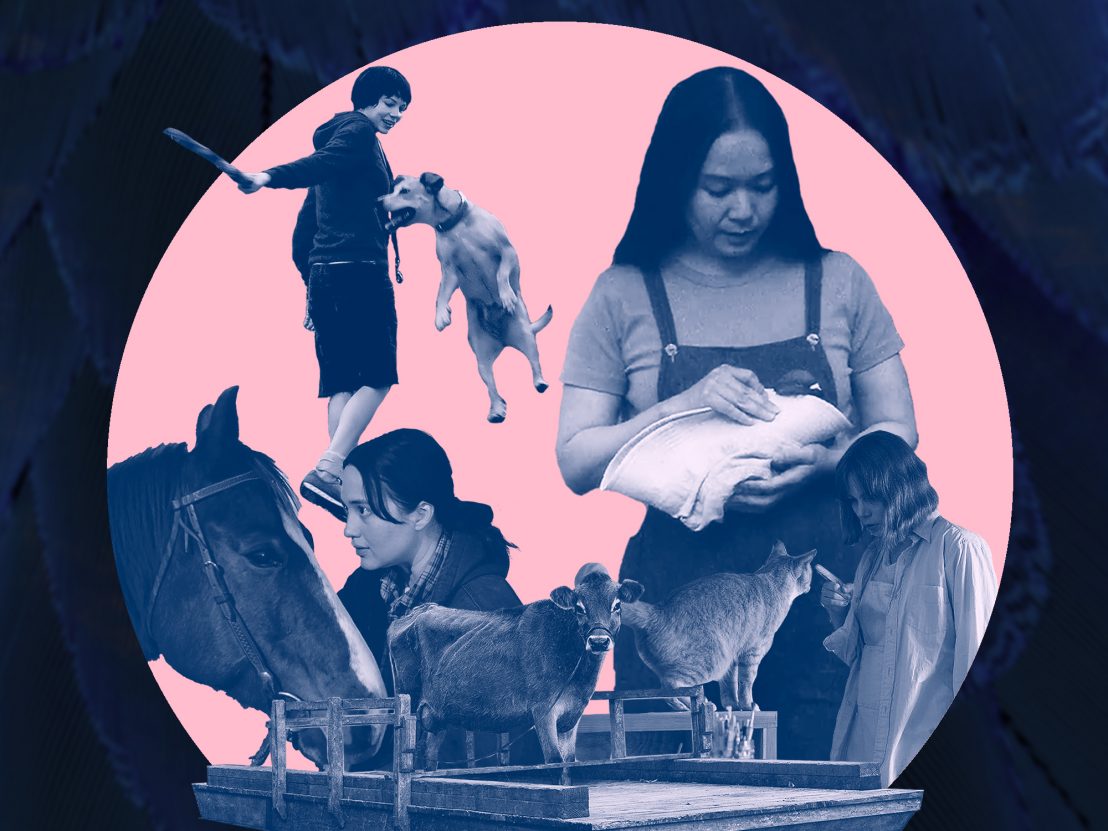
In Showing Up, the 2022 feature from celebrated independent director Kelly Reichardt, a peculiar relationship between a human and a non-human occurs. Lizzy, a 40-something sculptor played by Michelle Williams, is a few days away from an important solo exhibition. Taciturn and tense, she divides her life between a full-time job as an admin assistant at a local art college, meticulously finishing her sculptures, and taking care of her ginger tabby cat Ricky. It’s the mischievous Ricky who brings a poor pigeon into her life, whom the distressed sculptor saves from the jaws of death and subsequently ferries around in a cardboard box for the majority of the film’s runtime while the pigeon recovers from its ordeal. “When in doubt, shoot birds”, says Reichardt. On her sets, there is always a second camera assistant that shoots birds. This cinematic credo led Reichardt to make a short film called Owl (2019) which is essentially comprised of a medium close-up shot of an owl before it flits away.
Animals have been consistently featured in Reichardt’s films. Dogs, cows and horses, each to a different extent, inhabit their own bioegalitarian spaces, providing a necessary nuance to the filmmaker’s revisionist agenda. Their presence highlights the vitality of human existence and the complexity of female experience, yet Reichardt transcends the seemingly anthropocentric constraints that privilege the human over the nonhuman protagonist.
As Laura Staab deftly notices “Reichardt’s cinema waver[s] in the in-betweens of ‘not this, but that’”. Never explicitly feline, avian, canine, or equine, Reichardt’s cine stories offer a vital ecofeminist and biophilic perspective on human and animal “becoming with” as Donna Haraway puts it in her book ‘The Companion Species Manifesto: Dogs, People, and Significant Otherness’. Animals in her films undoubtedly serve a symbolic function, yet Reichardt portrays them as material, tangible, and agential beings without imposing a ‘story’ on them. This is the heart of Reichardt’s idiosyncratic style and spirit – in its non-possession of the filming subject, be it human or non-human.
Doreen St. Félix in her recent New Yorker profile of Reichardt describes her as “[America’s] finest observer of ordinary grit”. Reichardt’s oeuvre centres on those who have been around though, at times, we don’t necessarily know – or come to know – what exactly they have been through. A Kelly Reichardt human protagonist usually finds oneself in a precarious situation, caught in the middle of an arduous journey like the frontier pioneers in Meek’s Cutoff and the young and jobless Wendy on her way to Alaska in Wendy and Lucy. They are often at odds with the world, being the female other or the marginalised other – they are outcasts, renegades and nonconformists. “My films are about people who don’t have a safety net,” notes Reichardt. Reichardt herself, after her first feature River of Grass (1994), a Malickesque not-quite-romantic story of two discontented outlaws trying to run away from their suburban lives, could not make another film for more than 10 years. In the words of Todd Haynes, Reichardt’s mentor and friend, Kelly was unfortunate not to have “a film school background, a calling-card short, some connection to money, or a penis.”
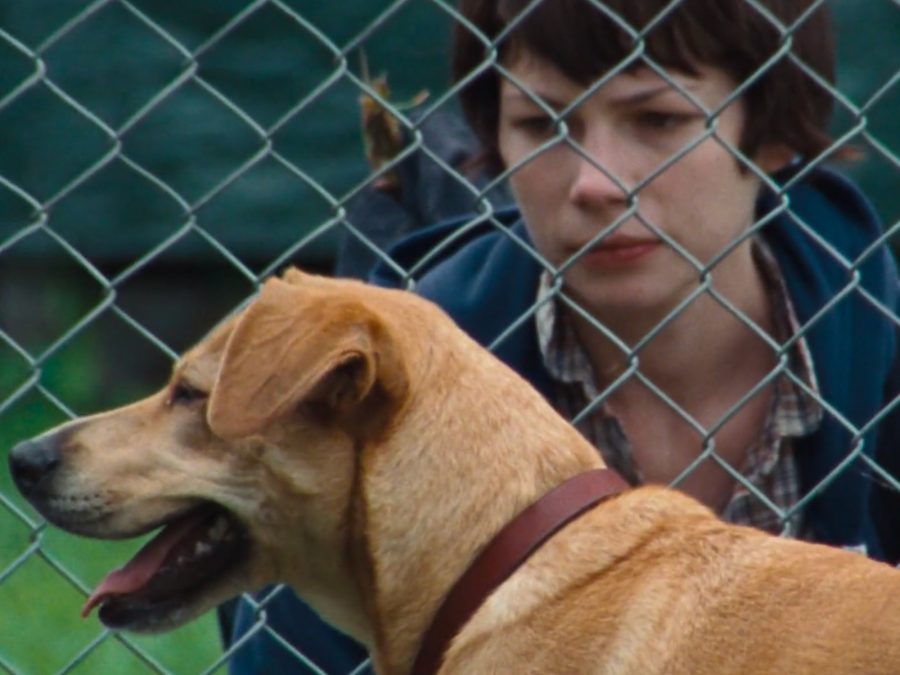
A Kelly Reichardt non-human protagonist typically serves as a companion, like mixed breed Lucy in Wendy and Lucy, or, more emblematically, as a marker of hope and rootedness like the eponymous cow in First Cow. Undeniably Reichardt’s favourite nonhuman subject is her own dog Lucy who made her screen debut in her second feature Old Joy (2006). Prominent for its subtle deconstruction of masculinity, Old Joy is a tale of impossible friendship between two old friends, Mark and Kurt, who reunite for a camping trip in the Cascade mountain range, yet are unable to restore their connection. The film’s non-human protagonist is Mark’s dog, Lucy. In Old Joy, Lucy is an indicator of Mark’s settledness: his first child on the way, he has a house and a job, whereas Kurt appears to be an unsteady hippy-like character. Lucy is Mark’s pet – symbolically the first step people take to creating a nice nuclear family.
In the spirit of non-possession, evocatively and empathetically, Reichardt films Lucy’s presence with gentle attentiveness and respect. Cinematography Peter Sillen’s camera observes the dog running up, down and around the human protagonists, exploring the trails of Oregon, and Lucy, seemingly, does not have a plot ‘function’. She is there on her own terms, not as a puzzle in the story. Old Joy conveniently fits in what Anat Pick calls “the cinema of letting be”. In one scene, Mark and Kurt, worn out and vexed about not finding Bagby Hot Springs, make a fire on the side of the road where someone has dumped a couch. Mark and Lucy are sitting on the couch illuminated by the warm light of the fire; Lucy, sitting on the left side of the couch, is practically invisible, yet is fully in the frame. She is just there sharing the space with the human characters.
The creation of Old Joy sheds even more light on Reichardt’s sensibilities of non-possession of the subject. In an interview with NYFF Director Kent Jones, she recounts how she had approached her longtime collaborator, writer Johnathan Raymond, to “lend” her a story which takes place outside and where she could “write a dog into”. This is how Lucy ended up in the film. Jokingly, Reichardt admits that for her a film has to have three elements: a road, animals, and nature.
Two years later Lucy stars in Wendy and Lucy, alongside Michelle Williams as Wendy. The female and the canine come together to tell a story of loss and sacrifice. Deceptively simple, Wendy and Lucy is already ambiguous in its title. Who is Wendy and who is Lucy? Both could be either, and both equally matter. The film revolves around Wendy as she makes her way to Alaska to be employed at a fish cannery. We find Wendy and Lucy in a Walgreens parking lot short of money and prospects. After Wendy’s failed attempt to shoplift some dog food for Lucy, she gets arrested, and upon release, Wendy realises that her beloved dog is gone. Eventually, Wendy finds that Lucy has been taken in and rehomed, but in the end, she does not claim the dog back. With tears in her eyes, she promises to come back to Lucy. But will she?
In Wendy and Lucy, Lucy’s role is more potent than in Old Joy and as if to assert Lucy’s visibility and agency, Reichardt includes her name in the title. Having said that, Reichardt approaches filming her in a similar non-possessive manner. Sentimentality is anathema to the filmmaker’s portrayal of animals. After all, it’s not a Lassie Come Home or Marley and Me kind of film. Reichardt’s camera lets Lucy be. When Wendy tries to sell some cans at a recycling facility, Lucy, on the leash, leaves the frame and re-enters it when Wendy pulls her back. Be it bioegalitarian ethics or transspecies solidarity, consciously or instinctually, Reichardt allows Lucy to leave the frame and appear again not as a trained cinematic performer but as a dog – because that is how and who she is. Whether a dog or an actor, Reichardt wants them to attune to each other’s becoming or way of being. “To be one is always to become with many” Haraway reminds us, pointing out the folly of human exceptionalism. So becoming one is always becoming with.
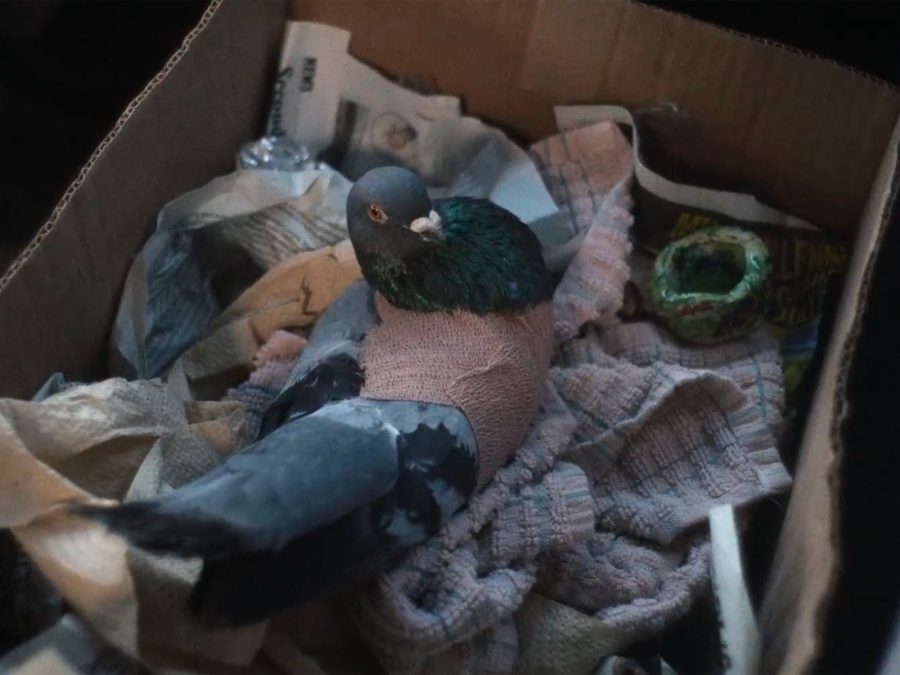
Speaking of trained animals, Reichardt straight-up hates working with trained animals. “Treat narcissists” she calls them for not being able to establish a relationship with an actor since what they are trained to have is a relationship with treats. Similarly, working with actors, Reichardt tries to limit the element of artifice. She does not run lines but rather asks her actors to learn to live, to be, like their characters. For Meek’s Cutoff, the actors learned how to pitch a tent and make fire without matches. For Certain Women, Lily Gladstone learnt how to tend horses and do the ranch chores. For First Cow, the actors went camping for three days and learned how to skin a squirrel. Filming chores, routines, and ‘non-eventful’ episodes, the filmmaker ultimately trades the artificiality of the carefully constructed genres for the interstices, in-betweens, and thresholds where something close to the mystery of life materialises.
While filming dogs in all their canine way of being, Reichardt portrays her bovine and equine protagonists in a more symbolic way. First Cow, her seventh feature, is a complex story of two wayfarers on the margins trying to make it. Like typical Reichardt protagonists, Cookie and King Lu are obstructed by social and economic hurdles of the 1820s Oregon and in order to increase their chances for upward social mobility, they steal milk from the only cow in the vicinity which belongs to a wealthy British trader to make oily cakes.
First Cow’s prologue alone – taken from William Blake’s Proverbs of Hell – hints at the necessity of connection with another being so as to secure protection and eventually solace. “The bird a nest, the spider a web, the man friendship”, the English mystic wrote in 1793. As the nest and the web are extensions of a bird’s and a spider’s way of being, so is friendship for a man. Therefore, the role of the cow in First Cow is rather symptomatic of one’s striving for security and peace. A cow – a much-desired commodity in the 1820s – could provide Cookie and King Lu with a way out of Oregon to their bigger dream – a hotel in San Francisco.
In Certain Women, horses perform a similar symbolic function. The film weaves together three stories of three women in small-town Montana, each of whom has her own trials and tribulations. Jamie (Lily Gladstone), the heroine of the last story, is a rancher who spends her days on the farm tending to horses. Long repetitive winter days are interrupted by the appearance of struggling graduate law student Beth played by Kristen Stewart with whom Jamie falls in love, albeit unrequitedly.
The horses that Jamie tends to – routinely and respectfully – emphasise Jamie’s connection with the land and her scant prospects in urban America. Moreover, they highlight Jamie’s queer subjectivity. Confident and skilful with horses, Jamie is shy and terse with Beth. She seems more comfortable with animals than people. In the film’s most moving scene – when Jamie comes to see Beth on a horse and offers her a ride to the diner – the horse for Jamie becomes almost a destrier (a mediaeval knight’s horse) signifying courage and devotion. Quite transgressively, with a subtle sexual undertone, the horse riding scene emulates a moment of intimacy and desire between the women as they are riding through the night.
Showing Up expands Reichardt’s animal menagerie to include two new animal protagonists – the tomcat Ricky and the injured pigeon. Ricky (in fact played by two feline actors) is akin to Lucy the dog – a loyal companion of a lone artist (a trope long noticed in popular culture). The avian character, on the other hand, omnipresent in Reichardt’s other films, moves from the periphery to the centre for the first time. There is a potent sense of parity between the wounded pigeon and the sculptor; the parity between nonhuman and human lives.
Of all birds, Reichardt chooses a pigeon – a bird that does not have a romantic public image. To most pigeons are an annoying token of modern city life, a nuisance that is dirty and abundant. It is not a colour-splashed songbird Reinhardt is after, but an ordinary bird that is anonymous, commonplace, peripheral just like Lizzy – an artist on the margins, far from a bourgeois lifestyle; the artist with a day job, a malfunctioning boiler and at times an unsympathetic landlord. The wounded pigeon is yet another burden on Lizzy’s shoulders (“Go die somewhere else!”). However, it is an average pigeon and not some extraordinary event that requires Lizzy to show up: for her work, for her family and for life. Lizzy’s existence is a repetitive cycle of pencil pushing and sculpting and it is the bird that brings some chaos to her routine. As cheesy as it sounds the pigeon symbolises freedom and the disorder of which creative life is made. Having recovered his wing, the pigeon sets itself free in the film’s closing mise-en-scène. “I guess it’s ready to go”, remarks Lizzy.
From Old Joy to Showing Up, Kelly Reichardt’s camera registers animals non-possessively, as bodies, forces and intensities. Her non-human protagonists are left to their own devices embodying life and nature. Like Agnès Varda’s gleaners, Kelly Reichardt gleans episodes, ordinary moments, chores, and routines that reveal the everyday politics of her human and animal protagonists, their ontological co-existence and attentiveness that one must attune to see beyond the gaze of her camera.
Published 1 Dec 2023

Michelle Williams excels as a sculptor whose attention is sapped by colleagues and family in Kelly Reichardt’s ambient social satire.
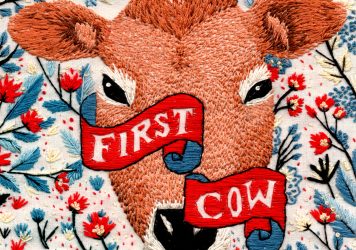
In celebration of Kelly Reichardt, one of America’s greatest working filmmakers, and her extraordinary new film.
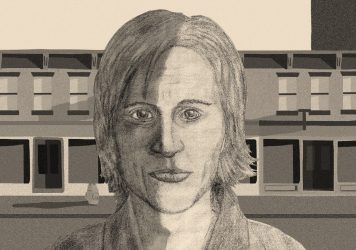
The American director talks Certain Women, working with Michelle Williams and why she’s ready to take a break from filmmaking.